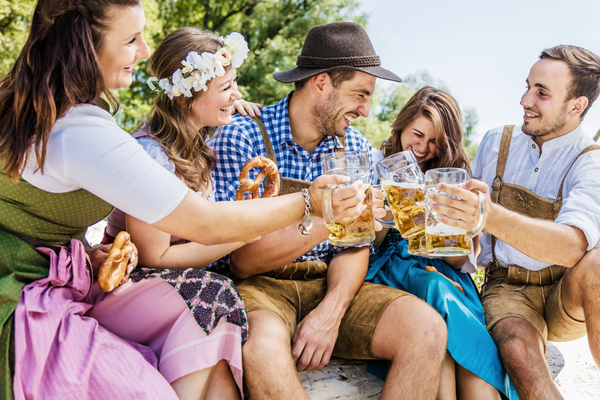The official sign of fall, for us, is the beginning of Oktoberfest! This festive celebration was established in October of 1810 by Prince Ludwig of Bavaria (crowned as King Ludwig I) in celebration of his marriage to Princess Therese of Saxony-Hildburghausen. The unusual thing was that the general public was invited to share in his celebration. At the time, such a thing was unheard of – nobles rarely associated themselves with the general public – however, some 40,000 Bavarians attended the celebration in Munich on what is now called Theresienwiese (the Teresa Meadow). Almost 200 years later, year after year, the celebration is held at the same location. “Wies’n” (the local term for the celebration, derived from Theresienwiese) is truly a Bavarian event that has become a celebration of life not only for Barvarians, but for all Germans and now the world, with some form of Oktoberfest happening in many cities and breweries.
Although major amounts of beer were had at the very first Oktoberfest, the event was initially built around its horse race and state agricultural show. The horse race has since been dropped, however the agricultural show continues and the festival has taken on many carnival characteristics. Oktoberfest now lasts 16 days, beginning in mid-September and ending on the 1st Sunday in October, with major Munich breweries sponsoring the event, up to 6 million attendees packing into mega beer halls and over 5 million liters of beer consumed every year.
If you happen to be in Munich for the OG Oktoberfest, be prepared: In 2017, the annual festival saw 6.2 million visitors. With 14 tents participating in the festivities, it can be quite daunting to choose the right one. For information on this year’s Munich Oktoberfest, go to http://www.oktoberfest.de.
The whole beer association/craze of Oktoberfest didn’t really happen until 1818, with the introduction of food and beer stands. The common Munich Oktoberfest beer served at Wies’n contains only 4.5% alcohol by volume, is dark/copper in color, has a mild hop profile and is typically labeled as a Bavarian Märzenbier in style – an amber lager with bottom fermenting yeast at 45º-55ºF. There’s confusion as to the origin of the style; however, it mostly likely came about hundreds of years ago, before refrigeration and before the first Oktoberfestbier. Beers brewed during the winter were kept in cold storage over the Spring and Summer months so that they’d keep. Some were also brewed to contain higher levels of alcohol to also help preserve. The label Märzen (March) soon signified beers brewed during the last months of Spring. These beers were then consumed over the Summer months when brewing was impossible due to the hot weather and bacterial infections.
Spaten, Paulaner, Ayinger and Hacker Pschorr are all exceptional must-tries, as they tend to be close in all aspects of flavor, smell and color. Usually reddish amber in color, very fragrant of deep-toasted malt, smooth, with the use of noble hops that make the beer spicy and herbal yet sweet and grainy. Domestic versions run the gamut, from being very close to their respected origins to brewing ale and calling it “Octoberfest Ale.” Sam Adams, Harpoon, Brooklyn Brewing, Saranac, Beck’s and Pete’s are good examples of the former, more traditional lagers. Some breweries, however, simply brew an ale and call it an Octoberfest beer … what’s up with that? Otter Creek and Wachusett Brewing just blatantly brew ale and slap “Octoberfest” somewhere on the label. Not to say these ales are bad, but these brewers have some guts to claim to be brewing one of the toughest beer styles when they’re not.
For more info on these beers and beers in general, visit the Beer Advocate website: (http://beeradvocate.com/beer/style/29/), They review Oktoberfestbiers throughout the season. In the meantime, pick up some Oktoberfestbier (or ale) while they are around. Then celebrate your existence! You have an excuse! Celebrate beer! Prost!
—
Photo Credit: KarepaStock / Shutterstock.com
